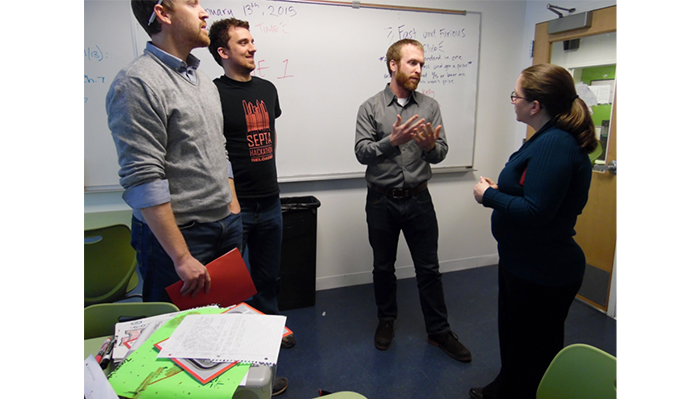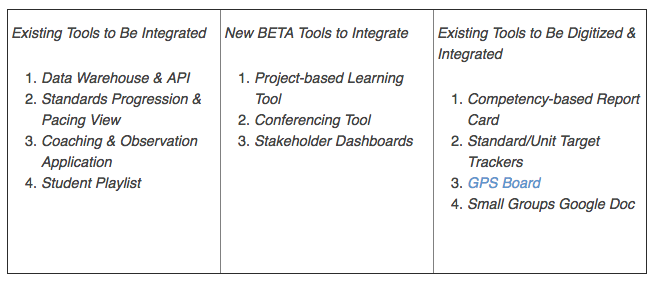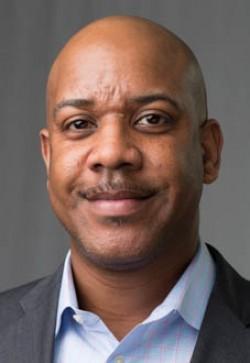When Schools Design Their Own EdTech Platform
Topics

Educators often take advantage of educational technologies as they make the shifts in instruction, teacher roles, and learning experiences that next gen learning requires. Technology should not lead the design of learning, but when educators use it to personalize and enrich learning, it has the potential to accelerate mastery of critical content and skills by all students.
Editor’s Note: This post is part of a series where Matchbook Learning’s Chief Technology Officer Al Motley examines the process his team is using to design, develop, and launch Spark 2.0, a technology platform that integrates multiple tools to create an ecosystem for students, teachers, parents, and administrators that supports student learning. In this interview with NGLC staffer Kristen Vogt, Motley talks about involving the organization’s executive team, the school’s leadership team, and teachers and students in designing Spark 2.0.
How did you launch the design of Spark 2.0 with your team?
We started with a kickoff meeting. It was a really important step for us. We used it to make sure that key stakeholders were aligned on the purpose and goals of Spark, that the groups involved knew each other’s roles on the team, and that everyone understood the steps of the project. The meeting helped us create excitement about this project, and we wanted to make sure to get into classrooms to see how teachers and students are using the tools we have now.
The success of a tech development project like this is often all about process. We are building buzz each step of the way, making it a big deal. We want everyone at the school to know that, “This is for you, to solve your problems.” During the meeting, our CEO, Sajan George, and I both tried to frame the project around what it means to Matchbook, to the education community, and to future students and schools that will use the tool. We set the tone for urgency and what it means for the organization.
“I think the key in framing was to appeal how Spark could and would further each strategic partner's respective mission. Too often customers with an IT project appeal to vendors in how they can better fulfill a customer's mission. The relationship can become transactional and cost driven very quickly. Two different missions with two different partners leads to a more strategic relationship that supports and drives Matchbook Learning's vision for Spark.”
–Sajan George, CEO, Matchbook Learning
Who is part of the team?
There were five different groups involved in the kickoff. The entire Matchbook executive team was there along with the Merit Prep leadership team. The project manager, design and development team for Spark 2.0 from Slate (the open-source platform that Spark 2.0 will be built on) participated. We also involved Fivestone, the design firm that does Matchbook’s branding and designed our website. Every teacher participated too.
We know it’s hard for teachers to be involved in this kind of work and keep up with their instruction, so we are consciously finding ways to meaningfully involve teachers. We did a survey before the kickoff meeting and shared a summary of their feedback during the meeting. Then, each grade level team of teachers came into the meeting for 45 minutes during their prep time. That time was after we spent an hour and a half observing four classrooms, so it was a chance for the rest of the group to reflect and ask questions, test their assumptions. Teachers were into the process, they didn’t want to leave when their prep period was over!
Five Stone’s involvement was extremely important, too, because the user experience is a big part of our effort. After the kickoff meeting, they led us through a three-week design process that ended with a set of design principles that would guide us through the tech development in a way that’s grounded in what teachers and students need. (And that’s a story for another blog.)
We felt it was really important for the Slate team especially to get into our classrooms. We wanted their team to see our school, our teachers, and our students in action, to understand how they use our current tools. Again, it’s all about the user experience for us.
What are the components of Spark 2.0?
With Spark 2.0, we are looking to integrate existing digital tools, paper and pen tools that we will convert to digital, and new tools we will create. This graphic shows the components of Spark, how we are building on what’s already working, and how we are reimagining how these tools can work together.

Here is the link to the GPS Board.
In the earlier “discovery phase,” we created a graphical view of the relationship of all our tools and features in Spark. We have a feature table that lists each tool along with design outcomes for each tool from each stakeholder: students, parents, teachers, school leaders, and Matchbook. And we have feature summary pages describing what each tool does now and what stakeholders wanted from each tool in the redesign. If anyone would like to see this or any of our materials, just get in touch with me.
We went through all of this discovery info during the kickoff meeting. It was a lot of info to go through but it was incredibly helpful for every stakeholder to see it all.
Looking back, how well did the kickoff support your goals?
What stood out to me that day was how aligned the core team was with what the teachers said they needed and the logistic issues we observed in the classroom. Asking for and getting their input and seeing what happens in the classroom was critical. At Matchbook, we always seek teacher feedback, but we usually structure the way they provide it. This time it was organic. We let questions fly. And they didn’t hold back. It felt very inclusive.
I think our partners at Slate could start to see overlap between our needs and existing tools they have already made. They could see how we’re using things and will be able to dive into the tech development from there.
I consider us a “needy” customer for our tech and design vendors because we are very specific about what we want and what we need. We took a hands-on approach to lead the process. I noticed during the meeting that we needed to do a better job clarifying the roles of everyone on the team. We took care of that while we were there at the table. I think this approach is helpful for developers so they have clear expectations and don’t have to do as much guesswork and build on assumptions.
What’s next?
After the kickoff meeting, there were two clear processes that started. We launched a three-week design process with Five Stone to reimagine our classroom tools. We also started building our “User Stories.” This process described every action a stakeholder or user could perform within all of Spark’s features. A huge task! I’ll write about the outcomes of that work—five core insights and five design principles—in my next blog post.




